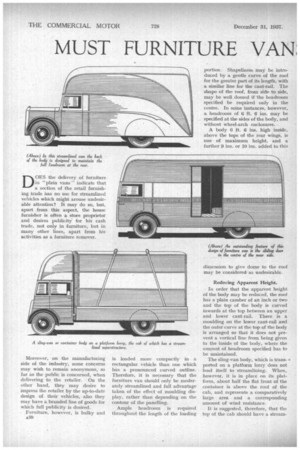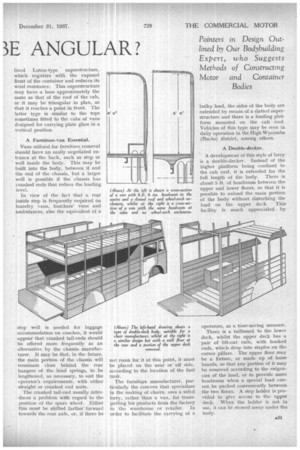MUST FURNITURE VAN IE ANGULAR?
Page 10

Page 11

If you've noticed an error in this article please click here to report it so we can fix it.
Pointers in Design Outlined by Our Bodybuilding Expert, who Suggests Methods of Constructing Motor and Container
Bodies
DOES the delivery of furniture in "plain vans" indicate that a section of the retail furnishing trade has no use for streamlined vehicles which might arouse undesirable attention? It may do so, but, apart from this aspect, the house furnisher is often a store proprietor and desires publicity for his cash trade, not only in furniture, but in many other lines, apart from his activities as a furniture remover.
Moreover, on the manufacturing side of the industry, some concerns may wish to remain anonymous, so far as the public is concerned, when delivering to the retailer. On the other hand, they may desire to impress the retailer by the up-to-date design of their vehicles, also they may have a branded line of goods for which full publicity is desired.
Furniture, however, is bulky and A30 is loaded more compactly in a rectangular vehicle than one which has a pronounced curved outline. Therefore, it is necessary that the furniture van should only be moderately streamlined and full advantage taken of the effect of moulding display, rather than depending on the contour of the panelling.
Ample headroom is required throughout the length of the loading portion. Shapeliness may be introduced by a gentle curve of the roof for the greater part of its length, with a similar line for the cant-rail. The shape of the roof, from side to side, may be well domed if the headroom specified be required only in the centre. In some instances, however, a headroom of 6 ft. 6 ins. may be specified at the sides of the body, and without wheel-arch enclosures.
A body 6 ft. 6 ins, high inside, above the tops of the rear wings, is one of maximum height, and a further 0 ins. or 10 ins, added to this dimension to give dome to the roof may be considered as undesirable.
Reducing Apparent Height.
In order that the apparent height of the body may be reduced, the roof has a plain camber of an inch or two and the top of the body is curved inwards at the top between an upper and lower cant-rail. There is a moulding on the lower cant-rail and the outer curve at the top of the body is arranged so that it does not prevent a vertical line from being given to the inside of the body, where the amount of headroom specified has to be maintained.
The sling-van body, which is transported on a platform lorry does not lend itself to streamlining. When, however, it is in place on its platform, about half the flat front of the container is above the roof of the cab, and represents a comparatively large area and a corresponding amount of wind resistance.
It is suggested, therefore, that the top of the cab should have a stream lined Luton-type superstructure, which registers with the exposed front of the container and reduces its wind resistance. This superstructure may have a base approximately the same as that of the roof of the cab, or it may be triangular in plan, so that it reaches a point in front. The latter type is similar to the tops sometimes fitted to the cabs of vans designed for carrying plate glass in a vertical position.
A Furniture-van essential.
Vans utilized for furniture removal should have an easily negotiated entrance at the back, such as step 01 well inside the body. This may be built into the body, between it and the end of the chassis, but a larger well is possible if the chassis has cranked ends that reduce the loading level.
In view of the fact that a rear inside step is frequently required on laundry vans, butchers' vans and ambulances, also the equivalent of a step well is needed for luggage accommodation on coaches, it would appear that cranked tail-ends should be offered more frequently as an alternative by the chassis manufacturer. It may be that, in the future, the main portion of the chassis will terminate close . behind the rear hangers of the hind springs, to be lengthened, as necessary, to suit the operator's requirements. with either straight or cranked end units.
The cranked tail-end usually introduces a problem with regard to the position of the spare wheel. Either this must be shifted farther forward towards the rear axle, or, if there be not room for it at this point, it must be placed on the near or off side, according to the location of the fuel tank.
The furniture manufacturer, particularly the concern that specializes in the making of chairs, uses a sided lorry, rather than a van, for transporting his products from the factory to the warehouse or retailer. In order to facilitate the carrying of a bulky load, the sides of the body are extended by means of a slatted superstructure and there is a loading platform mounted on the cab roof. Vehicles of this type may be seen in daily operation in the High Wycombe (Bucks) district, among others.
A Double-decker.
A development of this style of lorry is a double-decker. Instead of the higher platform being confined to the cab roof, it is extended for the full length of the body. There is about 5 ft. of headroom between the upper and lower floors, so that it is possible to unload the main portion of the body without disturbing the load on the upper deck. This facility is much appreciSted by
operators, as a time-saving measure.
There is a tailboard to the lower deck, whilst the upper deck has a pair of lift-out rails, with hooked ends, which drop into staples on the corner pillars. The upper floor may be a fixture, or made up of loose • boards, so that any portion of it may be removed according to the exigencies of the load, or to provide more headroom when a special load cannot be packed conveniently between the two floors. A step ladder is provided to give access to the upper deck. When the ladder is not in use, it can be stowed away under the body.
































